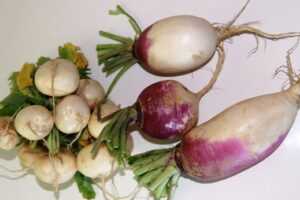A Fairy Tale Turnip
As a child, we had an old storybook with innocent, old-fashioned drawings in light colors. I don’t remember the plot of any of the stories, but I do recall that one was about a turnip. The children in the story sowed a turnip in their yard, or ate it for lunch or something along those lines. I remember we kids being astonished: what is a turnip? We imagined it to be an exotic European vegetable that only grows in harsh winters (maybe the children in the illustrations were wearing coats?), and with a heavenly taste (cause the children seemed so happy from their delectable meal). In Israeli reality, the turnip rates very minimal acclaim. It is considered to be a boring, tasteless vegetable. But in stories, it is generally highly regarded.
The well-known “Eliezer V’HaGezer” story is originally the tale of a huge turnip that required the cooperation of all members of the household to pull it out of the ground. The original Jack O’Lantern was an Irish drunkard who scooped out the insides of a turnip and placed a candle inside to act as a lantern.

A Grimm Brothers tale tells of two brothers, one rich, one poor. The poor brother grows a huge turnip in his yard, and because he can’t figure out what to do with it, brings it to the king who enthusiastically rewards him with a huge fortune of gold. When the rich brother hears, he comes to the king with his own gift: gold and horses. The king is enthralled by this gift, and in thanks, sends the rich brother home with his gift: a huge turnip.
But beyond fairy tales, the turnip deserves real respect for being a truly great vegetable. True, it’s probably underrated because its mild taste is less pronounced than other vegetables. Which is unfortunate, because I fear we’re getting used to the strong tastes of over-seasoning, brought to us by fast food and nosh that bombard us with overbearing flavors. We then miss out on the more gentle savors, the ones that don’t grab the stage and holler. Many times, they’re the ones hiding the treasure…
The modest turnip is an ancient cultivated crop, known in Greece, Rome, China and ancient Egypt. Its origins are in China, Central Asia and the Near East. In Israel, the turnip was grown during the times of the Mishnah, where it is mentioned as a popular garden vegetable. It belongs to the Cruciferae family, a cousin to cabbage, broccoli, cauliflower, kohlrabi, arugula, mustard, horseradish, radishes and others. Like the rest of the family, the turnip favors a cold winter climate that slows down the plant’s breathing and raises the quantity of the carbohydrate reserve, a process that improves its taste. Variable, unstable conditions will produce a woody root and strong flavor, and the turnip turns bitter if the weather is too hot or dry. Perhaps that’s the reason for the Israeli turnip being a true winter vegetable. The plant develops a dense root with a crown of leaves atop its head, similar to the radish. There are many varieties of turnip: spherical, round, oblate and skewered, and their colors range from pink to purple to yellow.
Here in Chubeza, over the past few years we have been growing the familiar turnip, the one with a purplish patch on top, as well as a special variety, a round white turnip that is oh so sweet! Even confirmed turnip-haters may see the light after taking one bite of these delectable treats.

In Israel, the root is the edible part, but in the Far East and southern United States it’s the greens that are eaten, with some species specially developed for their leaves (similar to beet root vs. beet greens). The root is eaten raw, cooked or pickled, and the leaves are cooked like spinach. There are countries that produce oil from the seeds.
Somewhere in cyberspace I read about a Canadian who married a gal from the US south, and one day they decided to have turnip for dinner. At the supermarket he placed a turnip root into his cart, to his wife’s astonishment. She was used to feeding the root to the hogs, and demanded the greens instead. He declared that as far as he’s concerned, the turnip IS the root, and greens are animal fodder. The moral to the story: a turnip’s beauty is in the eye of the beholder (and both its root and greens are delicious).
So indulge yourself with turnips in everything from soup to meat dishes to cholent. Use the turnip as you would a carrot (crusted, steamed with butter, glazed) or a potato (chips, pureed). Combine long, thin pieces of raw turnip (made with a peeler) in a vegetable salad. Or, while it’s young and raw, pickle it for two days in a sweet and sour brine consisting of a cup of plain vinegar, a cup of water and a cup of sugar boiled together.
The turnip also has medicinal qualities. According to Nissim Crispil, it relieves coughing and hoarseness, mucus buildup and breathing problems. In natural medicine, quaffing turnip juice is said to improve your mood (and some of these recipes are bound to give your mood a boost!) It is also beneficial for the kidneys. Turnip roots contains calcium and potassium; drinking turnip-green juice aids in neutralizing excess blood acidity and fortifying bones, hair, fingernails and teeth. Just 500 grams of turnip root will produce a glass of juice beneficial for anemia, arthritis, asthma, disruptions in the menstrual period, bladder obstruction, heart disease, fever, and kidney, liver and lung function. And 500 grams of turnip greens will produce half a glass of juice (one quarter in the morning, a quarter in the evening) to heal a cough, ease a hoarse throat, and remedy hair loss.
To your good health, and Bon Appétit!
Alon, Bat Ami, Dror, Yochai and all the other Chubez’O’Lanterns
_________________________________
WHAT’S IN THIS WEEK’S BOXES?
Monday: Lettuce/mustard greens, coriander/parsley/dill, potatoes, kohlrabi/fennel, tomatoes, Swiss chard/kale/spinach, cucumbers/red bell peppers, sweet potatoes, carrots, broccoli/cabbage/eggplant, turnips/beets.
Large box, in addition: Arugula/totsoi, Jerusalem artichokes, celery.
Wednesday: Lettuce, mustard greens/arugula/totsoi, coriander/parsley/dill, kohlrabi, fennel/turnips/beets, tomatoes, Swiss chard/kale/spinach, cucumbers, sweet potatoes, carrots, small boxes: broccoli/Jerusalem artichokes.
Large box, in addition: Jerusalem artichokes and broccoli, celery, radishes.
And there’s more! You can add to your basket a wide, delectable range of additional products from fine small producers: flour, fruits, honey, dates, almonds, garbanzo beans, crackers, probiotic foods, dried fruits and leathers, olive oil, bakery products and goat dairy products too! You can learn more about each producer on the Chubeza website. Our order system also features a detailed listing of the products and their cost. Make an order online now!
